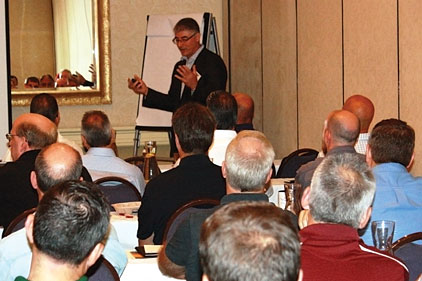These self-proclaimed “wet heads” met in Providence, R.I., Sept. 11-12 for the inaugural Hydronics Roundtable, presented by the Air Conditioning Contractors of America’s (ACCA) Radiant & Hydronics Council. The two day contractor-led conference featured numerous learning lab sessions focusing on proper installation techniques, radiant and hydronics efficiency, future trends, and how to integrate hydronics into a forced-air HVAC business.
Broadening Horizons
Stack Heating & Cooling, Avon, Ohio, first opened in 1976. The company ditched forced-air HVAC installations in 1990. From that point on, the company focused its efforts completely on hydronic systems in a community where few water-comfort contractors operated.
“Forced-air systems limit a homeowner on what he or she can do in the future. Using water as a medium heat transfer, your options are unlimited,” said Brian Stack, president.
“You can change the way a room functions using water temperature, and the implementation of chilled water in residential applications offers cooling options without having to cut the house up or stock 10 condensers outside.”
Stack said his crew has benefited from the variety of options hydronics offers.
“In our area, we are now the specialists,” said Stack. “We’ve done very well because we took the time to learn about the different types of systems and used them to offer efficient solutions that adequately solve a customer’s needs.”
Consumers aren’t taking the price of energy seriously because the cost is relatively low, said Stack. As costs continue to increase, much like the price of gasoline, more and more individuals will begin to look for cheaper alternatives.
“Adding hydronics options to your forced-air offerings will make a big difference. You’ll be able to offer solutions that are more efficient and flexible today, and for years down the road,” he said. “If things are done right today, and the proper system is installed, it’ll save you the hassle of becoming the scapegoat when energy prices grow to unbearable levels.”
The Advantages of Water
Richard Trethewey, president, RST Thermal, Westwood, Mass., — most widely recognized as the host of “This Old House” — believes hydronic and radiant systems offer numerous benefits. “If I put a Btu of energy into water, it sticks. If I put that same Btu into a forced-air system, about 75 percent of it doesn’t stick. That’s the reality,” he said. “I can hold about 3,500 times more energy in a pipe than I can a duct. A ¾-inch pipe can hold the same amount of energy as an 8-inch by 20-inch duct.”
John Barba, contractor training manager, Taco Inc., said when a consumer purchases a boiler, he or she needs to understand that it isn’t a money-making device as much as it is a money-saving machine.
“A boiler purchase is not an investment. A boiler provides a service. It keeps the occupant warm. It isn’t a slot machine. A homeowner isn’t going to spend $1,000 on a boiler and expect $3,000 back through a jackpot,” he said. “However, if the end goal is to provide as much comfort as possible, for as little money as possible, it’s the way to go. The value is demonstrated through fuel consumption and cost, which are the tools you, as a contractor, should be utilizing.”
Greg Jannone, president, Jannone & Sons, Bound Brook, N.J., said it may take some convincing, but once the system is installed, occupants rarely complain. “When we first started out, we had to fight hard for most of the systems we installed. We had to have direct contact with the consumer, and it proved to be very difficult,” he said. “However, I still service some of these systems that we installed two decades ago. These systems still feature the same three-way thermostatic valve, and these people still love their radiant systems.”
John Siegenthaler, principal, Appropriate Designs, Holland Patent, N.Y., said the attractiveness of a hydronic system lies in its versatility.
“You can build a simple system when needed, and if you are in a mega house, you can provide all the complexity they want,” he said. “As a contractor, you get to select which part of that spectrum you want to work in. But, the key is to promote hydronics as the vehicle to ultimate comfort. As a group, we really need to share just how noninvasive a hydronics system is, and the versatility it provides.”
Future Trends
At the conclusion of the roundtable event, a group of experts shared their opinions on what trends will define the next five years. “ECM circulators will become the new norm in hydronics,” said Siegenthaler. “European efficiency standards are requiring this already and we’ll soon see these systems in the U.S. Another trend is individual Btu metering stations, which will keep track of flow rate and temperature drop, thus keeping track of how much thermal energy has passed into a space. The occupant will then be billed based on that.”
Bob “Hot Rod” Rohr, national training manager, Caleffi North America, Milwaukee, believes the hydronics sector is getting smarter.
“We have smart pumps on the market, and with smart boilers that can modulate, smart valves, and zone valves with microprocessors in them, I certainly identify this growing intelligence as a trend,” said Rohr. “I also feel that low temperature distribution systems will emerge, which is good for our industry. It would be nice if we can get down to 120- or 140-degree distribution temperatures — the lower, the better.”
Robert Bean, Healthy Heating, Calgary, Alberta, Canada, said the hydronics industry will be reliant on individual energy sources that match the load requirements of each building. “We’ll be working with high-performance structures that have loads so low that we can eliminate the use of combustion and compression altogether. This means using larger heat exchanger areas, which will call for lower temperatures,” he said. “As load sizes are reduced, they become almost micro sized. I believe the solution lives in the creation of community-based heating plants. If you have 100 homes with low loads, and you collect that load and apply it to a community-based plant — perhaps located in a cul-de-sac — the load will be shared and demand will be accomplished. This is necessary for sustainability in the world.”
Bean further stressed that contractors need to identify hydronic and radiant options as appliances, not customizable luxury devices.
“I can’t see this industry growing without contractors getting over the fact that hydronics is a consumer product,” he said. “Treating these systems as customizable designs is destroying the image of hydronics. We’ve been fighting this for 30 years, and we haven’t gotten anywhere because we still define this as custom work.”
A Worthwhile Experience
Attendees certainly walked away with a wealth of information and many new ideas to incorporate into their businesses.
Richard Roth, AN Roth Co., Louisville, Ky., said he will take back what he learned and use it as a building tool.
“I don’t have a lot of experience with these types of systems, being from Louisville,” he said. “The stuff I learned here, especially the high-level hydronics stuff, it’s all great information to know.”
David Schneider, project manager, Hyde-Stone Mechanical Contractors, Watertown, N.Y., said the learning labs offered a ton of information to process. “I really enjoyed John Siegenthaler’s course on hydraulic separation and John Barba’s cost analysis breakdown. Both of those sessions were great,” said Schneider. “I’m no expert on hydronics, I mean I’ve done a few, but this was a great learning tool for me.”
Oleg Slivinsky, founder, Homegreen, Brooklyn, N.Y., said the course may have led him toward a career-altering decision.
“I actually designed my own house and that is how I got into this field,” he said. “I’m still feeling out what the niche market is, but, after this conference, I feel I like it so much that I’m seriously contemplating switching my career.”
Publication date: 10/15/2012











